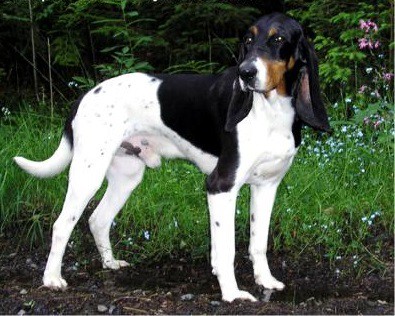Type the name of the breed you're looking for below
[wpdreams_ajaxsearchlite] Don't see the breed your're looking for? Click here and let us know!
Breed Characteristics
1 paw - breed exhibits the least amount of this characteristic
5 paws - breed exhibits most amount of this characteristic
Swiss Hound, Bernese Hound
| Other Names | Berner Laufhund; Bernese Hound; Schweizer Laufhund-Chien Courant Suisse |
| Country of Origin | Switzerland |
| Weight | 33 - 44 lbs. (15 - 20 kg) |
| Height (at withers) | Males: 19.5 - 23 in. (49 - 59 cm) Females: 18.5 - 22.5 in. (47 - 57 cm) |
| Coat | Short, smooth and dense |
| Colour | White with black patches or black saddle; light to dark tan markings |
| Litter Size | 3 - 6 puppies |
| Life Span | 12 - 14 years |
| Origin & History | The scenthounds of Switzerland are called laufhunds ("walking dogs"), or dogs to follow on foot, and like the French hounds, they have existed for a millennia. A mosaic discovered at Avenches includes a pack of hounds that strongly resembles the Swiss Hounds. Italian dog fanciers sought them out in the 15th century, and by the 18th century, the French embraced them for their exceptional hare-hunting ability. The fact that they were widely known in Europe through the Middle Ages contributed to their development into five distinct varieties: the Bernese Hound, the Jura Hound, the Lucerne Hound, the Schwyz Hound, and the St. Hubert Jura Hound (now extinct). Each of these varieties was also bred down into a smaller type, known as neiderlaufhunds, or small Swiss Hounds. There were individual standards for each of the Swiss Hounds by 1882. In 1933, a single standard was drafted for all of the varieties, of which there remained only four. (The St. Hubert Jura Hound had disappeared.) Today, the Swiss Hounds are popular mostly in their native country of Switzerland, where they are all still used as resourceful hunters of hares, foxes, roe deer, and boars. All of the varieties are similar, except for colour and size. The Bernese Hound variety was probably named not for the city of Bern but for the Bernese Alps, which are further south. They are closely akin to French hounds like the moderately sized Ariegeois and Chien d'Artois. |
| Personality | The Swiss Hound is an extremely loyal companion as well as an exceptional hunting partner. They hunt independently, tonguing to alert the hunter to his whereabouts. They are steadfast and determined even over difficult terrain. When not working a scent, they are docile and sensitive, happy to come inside after a hard day's hunt and sleep with the family. All of the Swiss Hounds have strong hunting and chasing instincts. |
Care Requirements
| Health | There are no known breed-specific health concerns. |
| Grooming | This dog does not require a large amount of grooming. Their smooth short-haired coat is easy to look after. Owners will simply want to make sure the coat is brushed on a consistent basis. These dogs should only be given baths when they need it. A wipe down with a damp towel should suffice for the bathing aspect, (although you should bathe it with mild soap only if or when necessary; you should also dry shampoo it occasionally), however a rubber, wire, or hard bristled brush would work best for the brushing aspect. The shedding patterns of these dogs are not known. Be sure to check the ears carefully for signs of infection. The nails should also be trimmed, (particularly to avoid nail-born infections). |
| Exercise | This is a hunting dog that needs extensive amounts of exercise. Without it, the dog could become problematic for its owners. It should be taken on walks daily, and this dog is great for healthy people who love to jog and hike. |
| Other Considerations | While it can live in an apartment, it may perform better in a small yard. It is important for owners to make sure this dog is never unleashed in an unsecured area, as it may run off in the direction of the first interesting scent it picks up. It is important for owners to make sure these dogs are given lots of space to move around in. |



